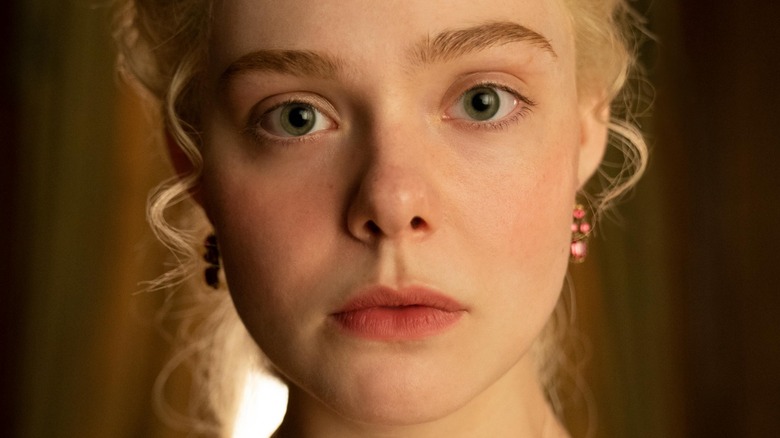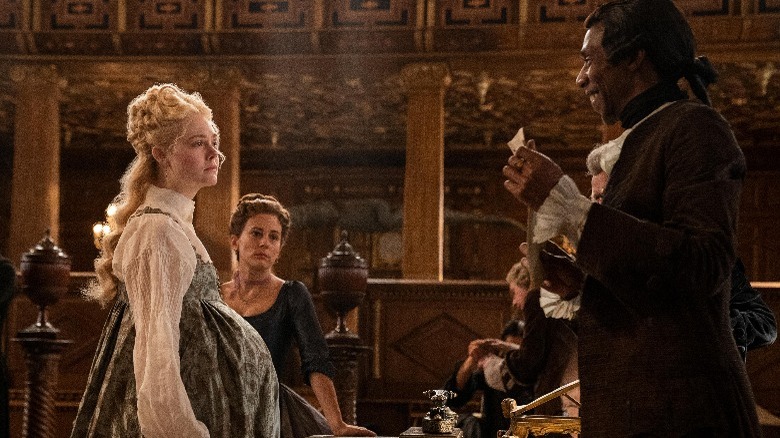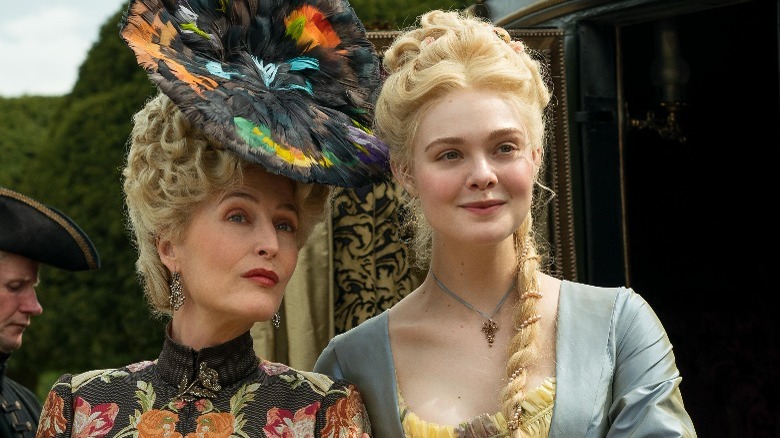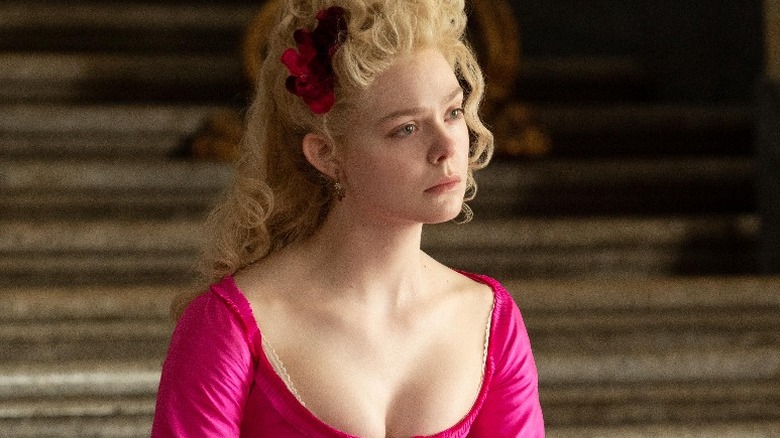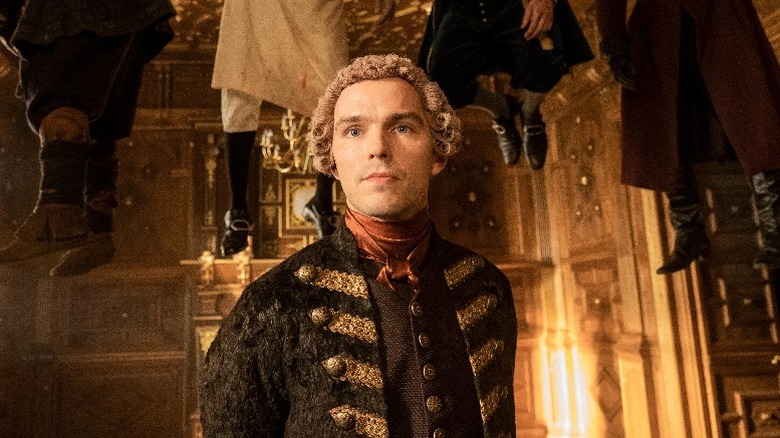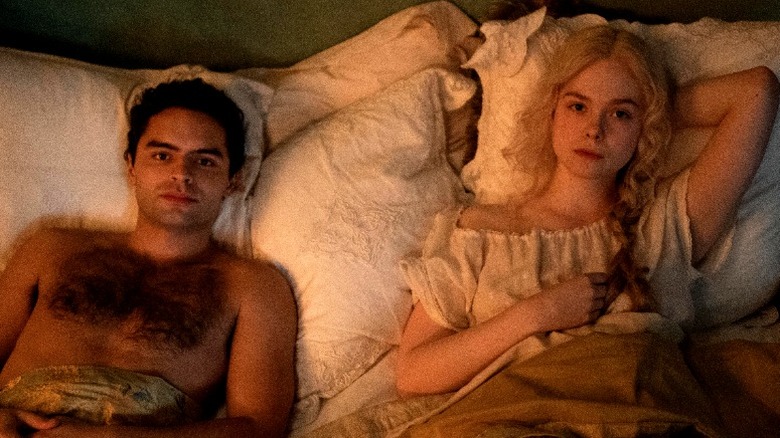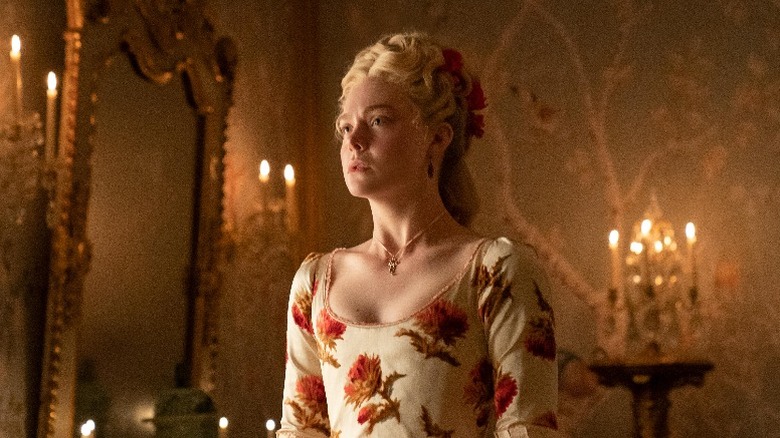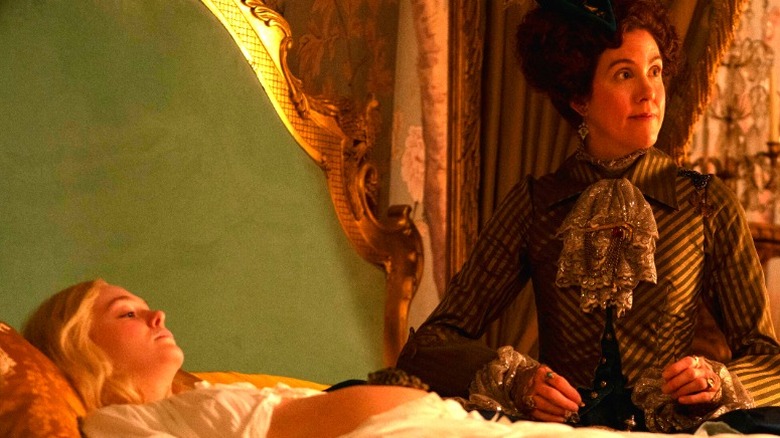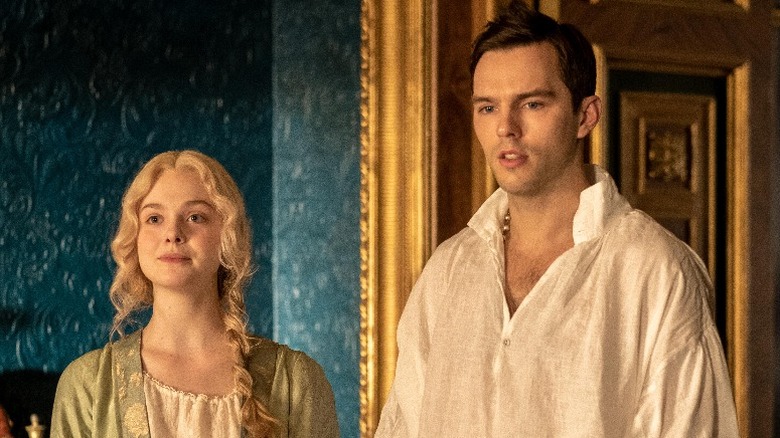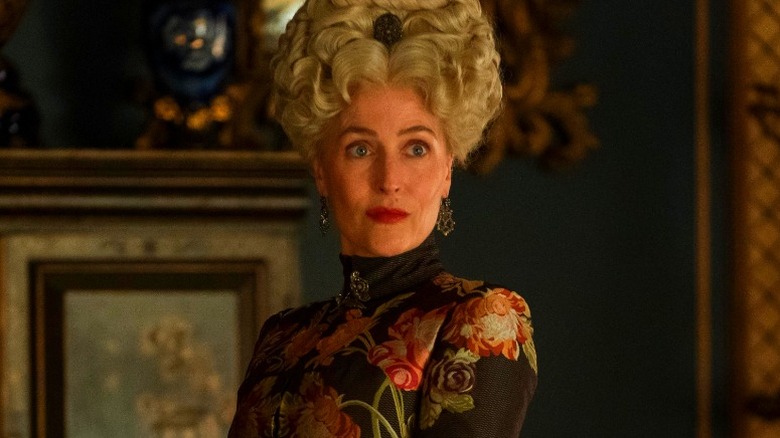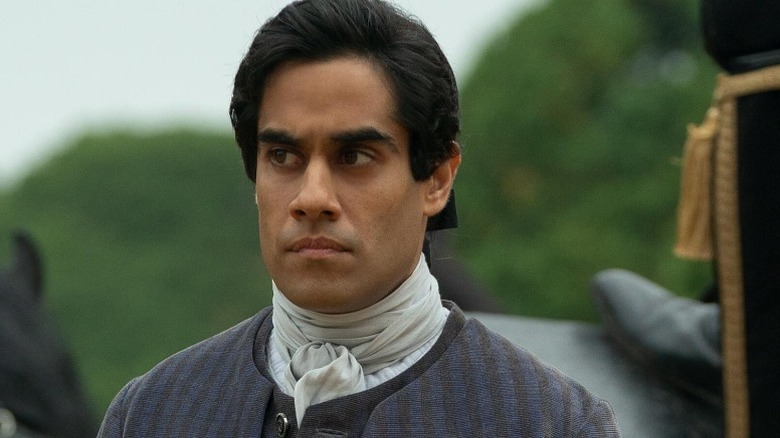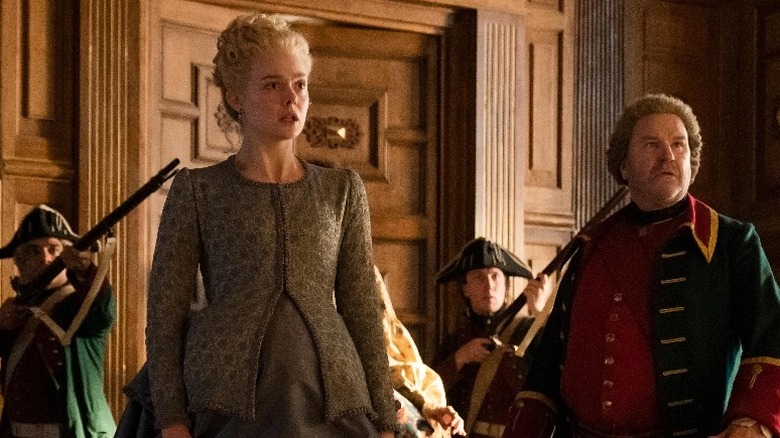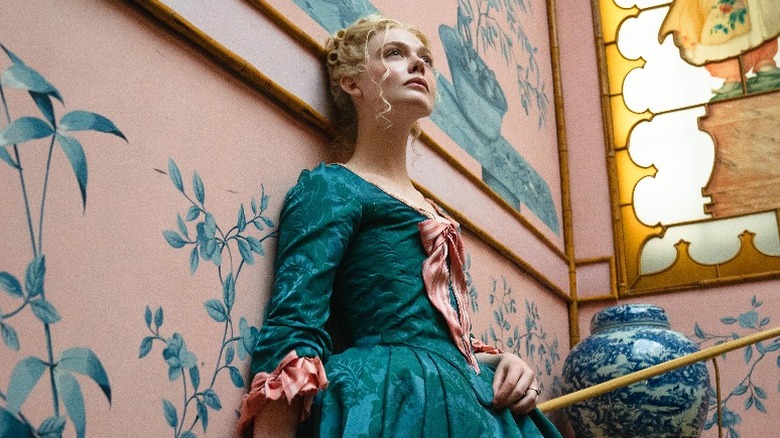The Untold Truth Of The Great
From the pages of a history book, the lives of those who shaped the world we live in today can seem colorless and far away. When these stories are brought to life onscreen, history comes alive with them — even if those stories are meant to be taken with a grain of salt. In this tradition, Hulu's "The Great" creates a window into the world of Russia's notorious Empress Catherine the Great, who didn't love the world she lived in and decided to do something about it.
Starring Elle Fanning as the eponymous monarch and Nicholas Hoult as her charming if terminally disappointing spouse Peter, the series is more of a hilarious tribute to the plucky leader infused with modern sentiment than a serious look at Catherine's long reign. From stimulant-fueled all-nighters and science fairs to bad wigs and uprisings, this wickedly dark comedy manages to keep the fun going in an era when heads were literally rolling. In the spirit of the Enlightenment, let's get into the untold truth of "The Great." Huzzah!
The show is loaded with anachronisms
The artistic license used in "The Great" doesn't end with changing up a few names and dates — fans of the show will find episodes wantonly peppered with anachronisms. Some are less obvious, but worth keeping an eye out for; for example, Count Orlov seems to zip up his pants after relieving himself in "The Beard." And viewers who look carefully at the party scene chandeliers will observe what look suspiciously like incandescent bulbs. And despite Catherine's boy toy Leo inventing the eponymous drink in "The Moscow Mule," the cocktail is actually a product of 20th century Manhattan origin, according to Newsweek. And it's not the only cocktail that's out of place in the series — in the Season 2 episode "Heads It's Me," Catherine creates Molotov cocktails with the help of a character named Molotov. Among the numerous other anachronisms included in the show are the card game Bridge ("War and Vomit"), Dom Perignon ("Parachute"), a Goya painting ("A Pox on Hope"), and the stapler ("Stapler"), which was first patented by George McGill in 1866.
The historical inaccuracies were created with purpose
Most viewers understand historical productions should be taken with a grain of salt. Sometimes, the real-life details are up for debate in scholarly circles, like whether Richard III killed the Princes in the Tower or Catherine of Aragon and Arthur Tudor ever consummated their marriage. And sometimes, historical inaccuracies are written in to make a story more interesting or easier to follow. According to Elizabethi.org, the films "Elizabeth" and "Elizabeth: The Golden Age" took quite a few liberties with history, and King Henry VIII's conspicuous lack of red hair in "The Tudors" is just the beginning of the Showtime series' dramatic license.
In a world of generally accurate storytelling with occasional deviations, though, a new genre seems to be emerging in which writers and producers gleefully and unapologetically favor good storytelling over faithfulness to history. Sofia Coppola's "Marie Antoinette" presented a candy-colored, irreverent look at the French aristocracy in its twilight, and as "Reign" star Anna Popplewell told Hollywood Life, the teen historical drama was more "fantasy history" than History 101. In the same spirit, the creative team behind "The Great" set out to tell a good yarn while hitting the key points of Catherine the Great's story, with the show's own title card warning viewers that it's only an "occasionally true story." Besides the obvious historical errors like the age of Ivan VI or the fact that Joanna actually died in exile, many of the relationships and storylines are completely made up. As series creator Tony McNamara emphasized to Vulture, "It's not a history lesson; it's a show."
The real Catherine's role in Peter's death is up for debate
Other than the unfortunate horse rumor, the real Catherine the Great was known for many things, chief among them her intelligence, her forward-thinking policies, and her love of the arts. And then there's the whole "ousting her husband and taking his job so she could completely reform Russia" thing. According to History, the pair never had a fantastic marriage, and Peter's shenanigans as a ruler were downright exhausting. When things between them rapidly spiraled only a few months after Peter took power as Emperor, Catherine saw and seized her opportunity.
Using the carefully cultivated support she had earned with the Russian people and army, Cat threw herself a good old-fashioned coup, forcing her husband to abdicate. Coincidentally or otherwise, Sneaky Pete ended up dead a mere eight days later. To add insult to injury, Peter's official cause of death was listed as what we can only presume would be the world's worst case of hemorrhoids and a touch of stroke. Whether Catherine had anything to do with those "hemorrhoids" or it was merely done by a Peter-fatigued go-getter has been debated ever since, with biographer Robert K. Massie concluding that the world may never know.
Nicholas Hoult did not use a body double for Peter's nude promenade
Working as a professional actor requires a certain degree of being comfortable in one's own skin. But that doesn't mean everyone is amenable to taking it all off for the camera, and fortunately, it's not always necessary. Whether they just don't feel great about the whole world knowing them on an intimate basis or there's another personal reason for their decision, some actors opt for a body double when a scene calls for a character to bare it all.
Nicholas Hoult, who plays Peter in "The Great," was fine with handling his own nude scenes, but unlike most actors, Hoult's character arc required him to show almost everything while walking down a very long — and fairly crowded — palace hallway in Season 1, Episode 6 ("Parachute"). In an interview with The Guardian, Hoult admitted the script gave him a moment of pause, and the actor even tried to negotiate for a smaller cast and crew that day. Eventually, Hoult says, he was able "switch off" part of his brain and channel the right energy, telling himself, "I'm Peter. And I feel so confident, and I'm so happy and enlightened, that I'm going to walk down this corridor naked."
Catherine was pretty sexually liberated for her time
The sex lives of royals — especially the women — have always been a hot topic of debate. For centuries, scholars have speculated over the boudoir activities of Elizabeth I and exactly how long it took Marie Antoinette and Louis XIV to work through their bedroom issues. And with hundreds of years' worth of gossip, rumors, and misinformation between their lives and the present day, it's hard to separate what really happened from the historical equivalent of fake news. When it comes to lascivious rumors, though, Catherine the Great was the target of some of the most scandalous in history including a savage legend that she died while romancing a horse — a falsehood "The Great" pokes fun at on occasion.
While Catherine's equine entertainments were hardly lewd, historians believe it's likely that the rumors of her fulfilling sex life are probably rooted in truth. According to Smithsonian Magazine, the Empress had 12 lovers — several of them much younger than herself. As her biographers observed, those romances took place over the course of her lifetime, and the Great was more of a "serial monogamist" than a one-hit wonder. Can you blame a monarch for wanting to Voltaire and chill?
The series is based on director Tony McNamara's play
Many of the TV shows we come to know and love get their start on stage or in the pages of a book, and "The Great" is no exception. Show creator Tony McNamara wrote a play by the same name years before the series hit Hulu, with the production premiering on stage with the Sydney Theatre Company in 2008. In an Australian Stage review, critic Brett Casben described the "lavish production" as a "visual feast that delights the senses and the imagination," noting that — just as in the later series — McNamara's notes emphasized the play was "not an historical account." The author set out to write a modern comedy, and when his interests were drawn to the real historical drama that defined Catherine the Great, he found a way to connect the two ideas. As McNamara told Vulture, the first two seasons of the Hulu series are taken from the first 40 or so minutes of the play, a story the writer calls "an organic mix of truth and fiction."
The wheat-based pregnancy test actually works most of the time
These days, anyone who needs to take a pregnancy test has only to shell out a few bucks at the drugstore, and the modern method yields fairly reliable results in a matter of mere minutes. But once upon a time, a missed period could mean any number of things, leaving the possibly pregnant person to wait in agonizing limbo for what could amount to months before confirmation. In the absence of advanced gynecological expertise and technology, folks devised some interesting strategies for determining pregnancy, and as with most pre-20th-century medicine, results could vary wildly. One such method shows up in the Starz series "Becoming Elizabeth" when a doctor declares Catherine Parr pregnant after ingesting a cocktail of her urine mixed with wine. Famed Greek medicine pioneer Hippocrates suggested giving the potentially pregnant a "a tablespoonful of honey with three of water, to be taken before going to bed or shortly after," and if their navel began to hurt afterward, a bun was in the oven.
Catherine the Great takes a different approach in "The Beaver's Nose" when she showers her royal gold all over a sprig of wheat, which blooms shortly thereafter. While this might seem absurd to modern viewers, there is actually some truth to this old-school EPT. According to the American Association for Clinical Chemistry, this simple urinalysis dates back to the ancient Egyptians, who used it to determine whether someone was pregnant as well as the child's gender. While it's probably not a great basis for a gender reveal party, a 1963 study published in the peer-reviewed journal Medical History found that the test seems to work at least 70% of the time for determining pregnancy.
Filming the sex scenes was a hoot for the cast
In the modern age of "Bridgerton" and "Outlander," it's hard to believe folks once had to work for their softcore historical smut by flipping through a Harlequin until they hit the NSFW section. These days, anyone can replay Jamie and Claire Fraser's wedding night as often as they wish (and who wouldn't?). But if you've ever found yourself mentally puzzling over exactly how these scenes are made to look so realistic, you're not alone. Although these steamy moments can seem incredibly intimate, it can take a whole team to make the scene work. An intimacy coordinator is an essential part of that team by making sure everything looks fantastic on film and everyone on set feels safe and comfortable during "simulated sex and other intimate and hyper-exposed scenes," according to SAG-AFTRA's Standards and Protocols.
Even though the final product looks seamless, sometimes filming these moments can feel a little silly, especially when the sequences in question are intimate scenes involving Peter and Catherine. Speaking with Entertainment Weekly about her character's saucier side, Elle Fanning emphasized the difference between Catherine's romantic moments with Leo and her more "bizarre" encounters with Peter. For the latter, Fanning says she was "biting a pillow laughing so hard," and at one point the pair of co-stars were "crying with laughter."
Gillian Anderson loved her character's exit
In a world where palace hallways filled with nudity, broken glass, and the occasional bear are the order of the day, the arrival of Catherine the Great's overbearing mother Joanna (played by Gillian Anderson) hits like a tidal wave. "The Great" is already full of larger-than-life personalities from the frequently drunk General Velementov (Douglas Hodge) to the original science denier Archbishop Archie, and the court needs a scheming Prussian socialite like a dog needs a parachute. And as often seems to be the case, Catherine and her mother have a troubled relationship, owing mainly to Joanna's merciless smiling criticism and manipulation of a daughter desperate for the slightest crumb of affection.
When Joanna takes a break from trying to have Catherine's allies killed, a romp with Peter turns deadly, with the deposed ruler accidentally pushing her out of a window mid-encounter. According to Elle Fanning, this dramatic turn of events was the detail that sold the role for Anderson. Fanning told Insider, "Basically, Gillian was like, 'That's why I want to do this.'" Anderson echoed the sentiment to EW, commenting, ""I thought it was brilliant, a brilliant way to end things" and offering up the possibility that Joanna might one day return in spirit form to haunt her daughter from the afterlife.
Orlo is inspired by Count Orlov
The complexities of palace life don't always translate easily to the narrative structures of film and TV, and with all the figures that shift in and out of the royal perimeter, sometimes it's easier just to shortcut the whole process with fictional characters that represent one or more real historical figures. "The Great" doesn't waste too much energy on bringing Catherine's real-world peers to the small screen, frequently subbing in a made-up alternative like Leo Vronsky, who seems to only generally represent any one of the real Great's lovers. And no Wikipedia entry will yield results on Cathy's good friend Marial.
But one character who appears to be based on a historical figure is the ponytailed bibliosexual Orlo (Sacha Dawhan), who becomes one of the Empress' most trusted advisors in the series. Like his fictional counterpart, the real Count Orlov was highly strategic and helped the would-be Empress orchestrate her husband's ouster. But in contrast with the bookish Orlo, Orlov was a military guy. Catherine liked him so much they had a child together, a son by the name of Aleksey Bobrinsky. When things between the couple took a turn for the worse and Catherine replaced him with an upgrade, he tried to win her back with a 200-carat diamond, but the bid failed. Diamonds might be a girl's best friend, but apparently they don't do much for an empress.
The royal court would have actually spoken French
Viewers watching "The Great" and expecting Russian accents will be quick to notice that the court of Catherine the Great uses primarily British ones. But throughout history, royals often hailed from countries or regions other than the one they would eventually come to rule. Before getting shipped off to France and her inevitable doom, Catherine the Great's younger contemporary Marie Antoinette was born and raised in Austria, where biographers like Nancy Goldstone say she crossed paths with Mozart when they were both children. The infamous Catherine de' Medici, whose father was Italian and mother was French, grew up in Italy before eventually coming to rule France. In a world where girls and women of royal lineage were traded as bargaining chips in the ultimate game of Risk, most royals were polyglots from a fairly young age with help from some of the best tutors money could buy.
The real Catherine the Great was born in Prussia and her second cousin and husband Peter III hailed from Holstein, both of which were located in what is now Germany. According to biographer Virginia Rounding, French was a lingua franca among royals during the Enlightenment and as such would have been spoken at court, as evidenced by Leo Tolstoy's epic novel "War and Peace." The enlightened empress also read Latin and was reputedly a big fan of Tacitus. And it didn't take her long to become skilled enough in Russian to churn out well over a dozen plays, fairy tales, and operas.
Some of Catherine's costumes were inspired by a Dior exhibit
For many viewers, half the fun of watching a historical production is the eye candy. From Claire Fraser's dreamy wedding dress to the Oscar-winning costume design in "Memoirs of a Geisha," these incredible outfits help anchor the story in time and place and add a fantastical element to the narrative. And just like every other element of production, a show's costume design choices can influence the storytelling. Take "Reign," which re-imagined its royals in a mashup of modern styles and vintage couture that vaguely capture the spirit of Elizabethan era styles. The switch was aimed at making the show more approachable for a teen and YA audience, with costume designer Meredith Markworth Pollack telling Observer that she incorporated plenty of bohemian pieces from Free People and plenty of designer fashions from Alberta Ferretti, Oscar de la Renta, Valentino, Isabel Marent, Givenchy, Marchesa, Temperley London, Alexander McQueen, and their ilk.
Since many designers draw on history for inspiration, it makes sense that costume creators would look to these high-fashion houses in turn. Like Pollack, "The Great" costume designer Emma Fryer found her muse in more modern designs, and told Fashionista that she drew a good deal of inspiration from the Victoria & Albert Museum's Christian Dior retrospective to create a soft but streamlined look befitting of "this determined, intelligent woman."
